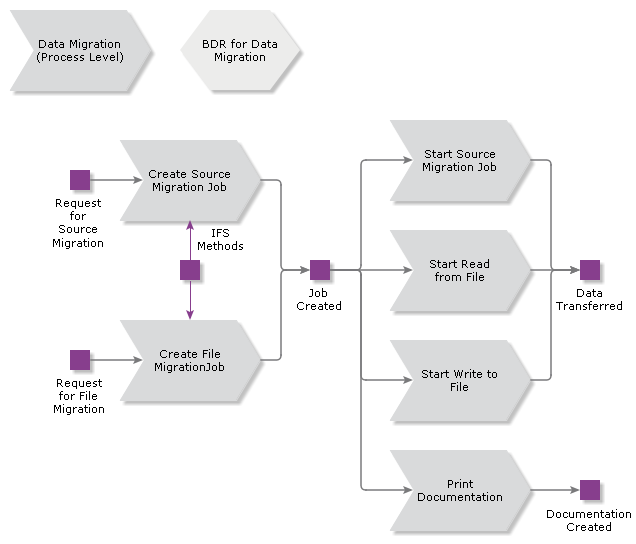Data Migration¶
This Data Migration Configuration guide is targeting for an application consultant or a super user who possesses adequate understanding of IFS Application components, their structure and logical relationships, SQL and PL/SQL languages.
IFS Data Migration is a tool that loads data from external sources into the application core objects in IFS Cloud. This tool is typically used to move data from previous legacy systems when an IFS solution is first implemented, or when systems are consolidated. The key advantage of IFS Data Migration is that it always loads data through the business logic APIs in IFS Cloud. Unlike other solutions that insert data straight into tables IFS Data Migration assures that business rules, validations, and integrity checks are never bypassed.
Data Migration jobs are highly configurable and multiple jobs can be chained together depending on your requirement.
Another strength of IFS Data Migration is that migration definitions can be packaged/exported and shared with other projects. The IFS Data Migration component itself contains a number of commonly used packaged migrations.
IFS Data Migration Tool¶
Data Migration is the process of transfer data from one location to another, one format to another, or one application to another. It is a challenging and complicated job due to the data gravity. IFS Data migration tool helps to migrate your data overcoming the complexity of data gravity. It allows you to migrate data through application business logic ensuring that the migrated data is valid at the destination.
The tool supports various types of Data Migrations such as File migration, Source Migration. In order to migrate data using IFS Data Migration tool, first you need to create a Migration Job. This migration job defines what type of migration is planned to do and its configurations such as the source and destination, metadata, how and when to start migration. Execution of a Migration Job is a separate thing. The job can be process either online or schedule it to run in background on a specific day, specific time or in a sequence. It allows to load and export data using files or DB LINKS.
Further, IFS Data Migration tool has supports for viewing the history of the executed migration jobs, Print the jobs details, use a conversion list to convert data before migrating, group migration jobs and authorize migration jobs to uses.

Read more about the concept Data Migration
Data Migration Today¶
IFS Data Migration is a tool that moves data into any application core object in IFS
- Takes advantage of standard API's
- Insert data into one or more LU’s in one pass
- Generic functionality may be combined with specially made scripts
- Not a tool that replaces conventional upgrade scripts
IFS Data Migration reads a number of different data sources
- Text files (flexible on separators, etc.)
- Tables or Views in Oracle database
- Via database link to other sources (not in Cloud offer)
- Directly from Microsoft Excel using the IFS Data Migration Excel Add-In
- Can join in information from already migrated data along with external sources
For each job execution, IFS Data Migration can provide history information about time of execution, time spent executing, number or errors and error messages for each failed row. Depending on the kind of error that occurred, the job may be restarted for error rows.
Migration jobs may be started online, in background, or scheduled to run on time intervals.
Several IFS Cloud components includes pre-packaged data migration definitions, including object such as users, customers and suppliers. These migration definitions is to make it easier to come up to speed when using the tool and to more quickly perform some of the migrations that are common to most projects. These prepackaged migrations consist of:
- The definition itself which is available upon manual installation of the PROD components as migration jobs in the form Overview - Migration Jobs
- An excel spreadsheet that may act as an input container for the data with additional information about fields, formats constraints, etc.
Main Data Flow in Data Migration¶
The following shows the abstract version of how the data flows from a Data Source into IFS Application Tables.

The data originates from a Data source. This can be a text file, Oracle source (table, view, db-link). Then a Data Migration Procedure converts this data into a attribute string(s). The content of the attribute string depends upon the configuration of the Migration Job. Then the attribute string is passed into New__, Modify__ methods. For other methods a dynamic procedure is created which takes the attribute string as input and then calls the actual method. These methods will do the relevant business logic validation and then save the data into the Database Tables.
Contents¶
-
Migration Job - Creating a Migration Job is the first thing one should do to migrate data.
-
Execute Migration job - To start Migrating data from source to destination, created migration job should be executed.
-
Migration Types - Migration can be discussed in five main types. Those are File Migration, Source Migration and import, export of a migration will be described in this area.
-
Execution History Analysis - Migration Job history is vital when it comes to trace back what had happened.
-
Scheduling a Migration Job - To execute migration jobs in background without user interaction.
-
Print Documentation - Describes how to get the documentation of a created Migration Job.
-
Basic Data Requirements for Data Migration - The Basic Data setup which is common for all migration job types. This includes setting up migration job default rules, groups, granting migration jobs to authorized users and setting up data conversion lists.
-
References - This section describes, Migrating Application Configurations, Known Limitations, Tips and Tricks